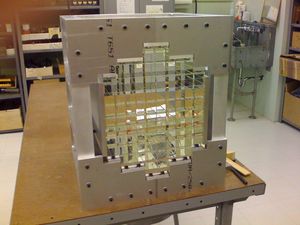Difference between revisions of "FCAL"
(→Shift Taker Reference Guide) |
|||
| Line 7: | Line 7: | ||
=== Shift Taker Reference Guide === | === Shift Taker Reference Guide === | ||
| − | * [[Forward_Calorimeter_Shift]] | + | * [[https://halldweb.jlab.org/hdops/wiki/index.php/Forward_Calorimeter_Shift FCAL Reference]] |
=== Mechanical Design === | === Mechanical Design === | ||
Revision as of 10:58, 23 February 2017
The GlueX FCAL consists of 2800, 4 cm x 4 cm x 45 cm lead glass blocks stacked in a circular array. Each block is optically coupled to an FEU 84-3 PMT which will be instrumented with flash ADC electronics. GlueX-doc 985,988 and 989 document the GlueX Fcal as presented in the February 2008 Calorimetry Review.
Contents
Shift Taker Reference Guide
Mechanical Design
- FCALPhotos
- FCALPMT
- FCALLeadGlass
- Light Guides
- Cosmic ray tests
Radiation Damage
Optical Measurements
Electromagnetic Background
Options for Radiation-Hard Insert
Readout Electronics
Below is a note from Scott Teige that proposes a timing algorithm for the flash ADC's based on studies with digitized PMT pulses that is based around using samples on the leading edge as inputs to lookup table on the chip to get rough timing information.
A frequent question is: What resolution is needed?
The FCAL timing resolution serves two functions:
- to suppress clusters or blocks that are due to beam related interactions that are out of time with the pertinent physics event
- in certain classes of events, like all neutral forward particles, the FCAL timing resolution is needed to unambiguously determine the beam bunch that produced the physics event so that the relevant tagger hit can be identified
Resolution needed for 1 depends on the background rate in the FCAL and the feeling is that something on the scale of several ns is sufficient -- this is probably easily achievable and essentially "comes for free" with the FADC, but we have to be careful about getting too sloppy because:
Resolution needed for 2 depends really on the tagger rate and the feeling here is that, due to the high rates, we really need quite pure tagging of the beam bunch. This likely requires an FCAL event time resolution on the scale of a couple hundred ps; however, this does not mean a single channel resolution of a couple hundred ps (see below).
A rough sketch of the noise suppression/event building would be:
- trigger notices spike in energy sum due to all neutral event
- FADCs and tagger paddles are read out over some time window around the trigger
- processing of event offline removes noise of type (1) above by looking for hits out of time with energy spike
- times from all blocks that are in time with the physics are averaged
- average time is used to determine event time and select tagger signal
There is an advantage that these high-energy all-neutral events will light many blocks, each of which generates a (nearly) independent event time determination. (Actually, the slightly varying cable lengths and transit times probably dither the signals across the synchronized FADCs.) In any case, these can all be averaged to help determine the event time. So the resolution must be good enough on a single channel to remove noise of type 1 and also, when averaged across many channels, the average needs to be precise enough for application 2. We should be able to check this with a simulation which includes noise and then independently verify the resolution using a PMT and real FADC. Our instinct though is that something on the scale of 800 ps - 1 ns (some sort of simple FADC algorithm) is probably sufficient. The note above indicates this sort of resolution is easily achievable.
CW Bases
Reconstruction
- Clustering algorithm from RADPHI: NIM A 570 (2007) 384
- Photon reconstruction: GlueX-doc-823
- Nonlinear energy and depth corrections GlueX-doc-1093
